| Construction Rating: | starstarstarstarstar_border |
| Flight Rating: | starstarstarstarstar_border |
| Overall Rating: | starstarstarstarstar_border |
| Diameter: | 1.64 inches |
| Length: | 34.77 inches |
| Manufacturer: | FlisKits  |
| Skill Level: | 3 |
| Style: | Futuristic/Exotic |

Brief:
Almost immediately after the Micromaxx TOG was released in 2006, Jim Flis was buried with requests for an upscale.
This 24mm version is a gorgeous rendition of the stylish, futuristic spacecraft design. It flies every bit as great as
it looks, too.
Construction:
Collectors will be pleased to know that I just increased the scarcity of the numbered kits by building #11. What can
I say? When you get your hands on a kit this cool, it's pretty tough to let it sit gathering dust for years.
The bag comes packed with plenty of quality parts, including:
- Balsa nose cone
- Balsa transition
- BT-60 main body tube
- BT-55 upper and side body tubes
- BT-50/24mm motor tube
- 1/8" balsa fin stock
- Laser cut fiber ramjet set (2)
- 16" plastic chute
- Kevlar®+elastic shock cord
- 3/16" launch lugs
- engine hook/block
This is listed as a skill level 3.5 kit on a 5 scale. That's reasonably accurate as there are some challenging scalloped tube cuts involved with this as well as some delicate fin shapes.
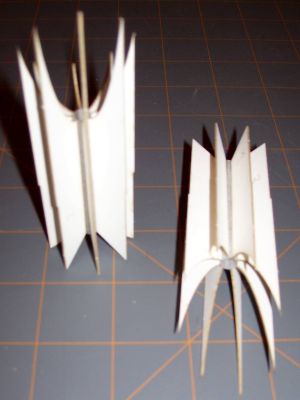 The instructions are excellent--very clear, easy to follow, and loaded with helpful
illustrations. There are a total of 34 numbered steps spanning seven 8.5" x 11" pages. Depending on how picky
you are on finishing, expect to spend a good 8-10 hours on the build, plus another full 8 on the finishing. This is not
a quick and easy build.
The instructions are excellent--very clear, easy to follow, and loaded with helpful
illustrations. There are a total of 34 numbered steps spanning seven 8.5" x 11" pages. Depending on how picky
you are on finishing, expect to spend a good 8-10 hours on the build, plus another full 8 on the finishing. This is not
a quick and easy build.
The motor tube takes a standard 18/24 centering ring as a block with a metal hook for retention, but since it is attached directly to the inside edge of the BT-60 main tube rather than via centering rings, the hook is held in place by a strip of gauze.
The next few steps involve cutting the BT-60 and marking the various fin attachment lines. If you've ever built either the Long Overdue, Just Past Due, or maybe the Night Whisperer/Farscape from FlisKits, then you've got an idea of what's involved in cutting the scalloped tubes. It does take a fresh, sharp blade, preferably a #10 X-Acto rather than a utility/razor blade.
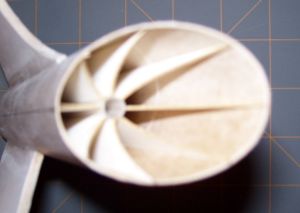 At this point, before following the instructions and bonding the BT-50 to the BT-60, you
might want to think through your paint plan. (You do have a paint plan, don't you?) If you want to get a nice finish on
the BT-50 and/or go with contrasting inner and outer tube colors, then you should mask off a thin strip to serve as a
bond line on each tube then paint them individually. Once everything is painted and dried, remove the masking tape and
bond the tubes together with some medium CA.
At this point, before following the instructions and bonding the BT-50 to the BT-60, you
might want to think through your paint plan. (You do have a paint plan, don't you?) If you want to get a nice finish on
the BT-50 and/or go with contrasting inner and outer tube colors, then you should mask off a thin strip to serve as a
bond line on each tube then paint them individually. Once everything is painted and dried, remove the masking tape and
bond the tubes together with some medium CA.
Cutting out the fin patterns is a little confusing if you're used to 3FNC style construction. For starters, there aren't more than 2 of any particular shape, they have weird names, and for a few of them there is no root/tip, but two different root edges. The really tricky aspect is that there are some very tight curves and corners, some of which will be cut across the grain. The instructions include a tip to laminate the fin stock first by gluing a sheet of paper to each side. That's an excellent suggestion as it also eliminates a lot of grain filling.
The main body tube (BT-60) winds up getting three fins--two side fins for the pods and a top/dorsal fin.
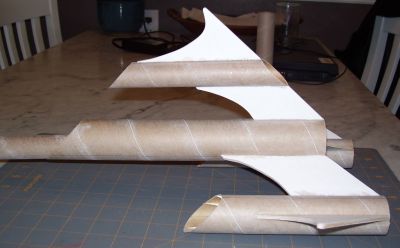 Next up comes the ramjet assembly, which is really a marvel of design and creativity. The
intake fins are laser cut to very precise tolerances. Once they are glued surrounding a launch lug, it fits perfectly
inside the BT-55 pod tubes. The only suggestion I'd make to improve this would be to whip up a marking guide for 8-fin
pattern around a 3/16" lug. It's pretty easy to get these out of alignment without properly spaced (and straight)
lines. Once complete, again consider the paint plan before bonding--you'll certainly want to paint these a contrasting
color, so paint first, bond later.
Next up comes the ramjet assembly, which is really a marvel of design and creativity. The
intake fins are laser cut to very precise tolerances. Once they are glued surrounding a launch lug, it fits perfectly
inside the BT-55 pod tubes. The only suggestion I'd make to improve this would be to whip up a marking guide for 8-fin
pattern around a 3/16" lug. It's pretty easy to get these out of alignment without properly spaced (and straight)
lines. Once complete, again consider the paint plan before bonding--you'll certainly want to paint these a contrasting
color, so paint first, bond later.
Two ramjet and one dorsal tube are cut from a BT-55, again using patterns and a fresh blade for the tapered cuts. They're bonded to the corresponding fins on the BT-60 and each gets some variation of an outer fin as well.
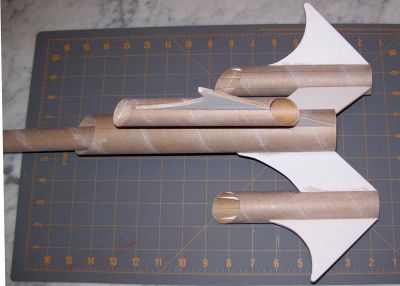 The upper section is basically a payload bay consisting of a balsa transition, a BT-55 tube,
and a balsa nose cone.
The upper section is basically a payload bay consisting of a balsa transition, a BT-55 tube,
and a balsa nose cone.
Construction wraps up by attaching the shock cord. The instructions suggest anchoring it to the inner tube BT-55/BT-60 seam, but I would suggest there are two problems with this. First, it's a little tough to get a good bond in there after the two tubes are already glued together, and second, you'll have a very visible externally anchored cord. I would instead suggest either a tri-fold mount to the motor tube or using a little extra Kevlar®, anchoring to the 18/24 centering ring motor block.
Finishing:
Finishing can be a lot of work on this as you have 6 tubes, 6 fins, and a pretty long balsa nose cone and transition
to fill and finish. I typically do all my spiral and grain filling before assembly, and that's certainly a must for
something as complex as this.
Since I pre-painted most parts, I was able to hold fairly closely to the stock paint scheme. I went with a green metallic for most of the body tubes, black fins and payload tube, and bright red ramjets. I had trouble getting a low humidity day and wound up getting a pretty feeble gloss, so also I applied generous touches of Future floor polish hoping to give it a good shine.
Construction Rating: 4 out of 5
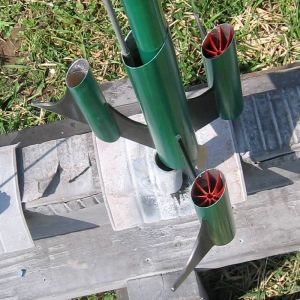
Flight:
The instructions specifically warn against using E motors, so the official recommendations are C11-3 and D12-5. I
would guess the warning is based on the lower initial spike of the E9, not so much the additional weight's impact on
CG, because on a D12-5 this was plenty stable, flying perfectly straight in 5-8 mph winds. If you really must go for
more power, I'd think an Aerotech E15 or even an F12 would be fine, although on an F12 you'd be hitting some insane
altitudes with this.
Recovery:
The chute supplied is the standard Flis 8/12/16 chute, where you cut whatever size pattern you want. In this case,
you'll need every bit of the 16 and should consider upgrading to a 24" if you have a spare. Under a 16"
chute, mine came down a bit hard, and naturally found the road, breaking off one fin on impact.
Flight Rating: 4 out of 5
Summary:
This is one of the coolest designs in the FlisKits fleet. I could see a bigger chute and different shock cord anchor
technique as improvements, but I wouldn't exactly call them "cons". The pros are first and foremost an
outstanding design, especially the ramjets. Second, it's a sweet flier. It's got styling and performance and is fun to
build. You can't go wrong with this beauty.
Overall Rating: 4 out of 5
 |
 |
Flights
 |
 |
Sponsored Ads
 |
 |












T. (September 26, 2008)